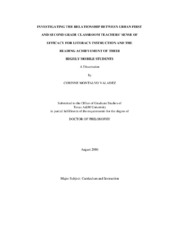| dc.contributor.advisor | Carter, Norvella P. | |
| dc.contributor.advisor | Larke, Patricia J. | |
| dc.creator | Valadez, Corinne Montalvo | |
| dc.date.accessioned | 2006-10-30T23:24:07Z | |
| dc.date.available | 2006-10-30T23:24:07Z | |
| dc.date.created | 2006-08 | |
| dc.date.issued | 2006-10-30 | |
| dc.identifier.uri | https://hdl.handle.net/1969.1/4180 | |
| dc.description.abstract | This correlation design study investigated the relationship between urban first
and second grade classroom teachers’ sense of efficacy for literacy instruction and the
reading achievement of their highly mobile students. Teachers’ sense of efficacy for
literacy instruction was shown in previous studies to be correlated to student
achievement.
To obtain data for this study, a modified version of the Teachers’ Sense of
Efficacy for Literacy Instruction Scale (TSELS) questionnaire was administered to 48
urban first and second grade classroom teachers within a single school district located in
the southwestern region of the United States. Students’ pre and posttest scores in fluency
and comprehension obtained from beginning- and end-of-the-year Texas Primary
Reading Inventory (TPRI) provided additional data on student achievement.
Analyses using a multivariate analysis of variance (MANOVA) determined that
there was not a statistically significant difference between urban first grade classroom teachers’ sense of efficacy and urban second grade classroom teachers’ overall sense of
efficacy for literacy instruction for their highly mobile students: F(2, 45a0 = .94, p = .40;
Wilks Lambda = .96 at p, .05; partial eta squared = .04. There was not a statistically
significant difference between first and second grade classroom teachers’ sense of
efficacy on the subscales of efficacy for integrating the language arts and differentiating
instruction.
Paired sample t-tests determined there was significant growth in the reading
achievement of highly mobile first grade students and highly mobile second grade
students. Independent samples t-tests found no significant difference in the growth of
reading achievement between highly mobile first grade students and highly mobile
second grade students. Finally, multiple regression analyses concluded that there was not
a statistical relationship between teachers’ sense of efficacy for literacy instruction and
the reading achievement of their highly mobile first and second grade students. | en |
| dc.format.extent | 688481 bytes | en |
| dc.format.medium | electronic | en |
| dc.format.mimetype | application/pdf | |
| dc.language.iso | en_US | |
| dc.publisher | Texas A&M University | |
| dc.subject | teacher efficacy | en |
| dc.subject | highly mobile students | en |
| dc.title | Investigating the relationship between urban first and second grade classroom teachers' sense of efficacy for literacy instruction and the reading achievement of their highly mobile students | en |
| dc.type | Book | en |
| dc.type | Thesis | en |
| thesis.degree.department | Teaching Learning and Culture | en |
| thesis.degree.discipline | Curriculum and Instruction | en |
| thesis.degree.grantor | Texas A&M University | en |
| thesis.degree.name | Doctor of Philosophy | en |
| thesis.degree.level | Doctoral | en |
| dc.contributor.committeeMember | Kaplan, Diane | |
| dc.contributor.committeeMember | Knight, Stephanie L. | |
| dc.type.genre | Electronic Dissertation | en |
| dc.type.material | text | en |
| dc.format.digitalOrigin | born digital | en |


